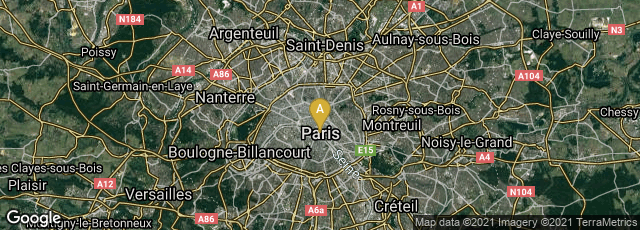

A: Paris, Île-de-France, France
Between 1782 and 1832 l'Encyclopédie méthodique ou par ordre de matières par une société de gens de lettres, de savants et d'artistes; précédée d'un Vocabulaire universel, servant de Table pour tout l'Ouvrage, ornée des Portraits de MM. Diderot et d'Alembert, premiers Éditeurs de l'Encyclopédie was published in 206 volumes by French publisher and writer Charles-Joseph Panckoucke and his daughter Therese-Charlotte Agasse.
The Encyclopédie méthodique was a revised and expanded version, arranged by subject matter, of the alphabetically-arranged Encyclopédie, ou dictionnaire raisonné des sciences.... compiled by Diderot et d'Alembert.
"Two sets of Diderot's Encyclopédie, and its supplements, were cut up into articles. Each subject category was entrusted to an exclusive editor, whose job was to collect all articles relating to his subject, and exclude those belonging to others. Great care was to be taken of those articles that were of a doubtful nature, which were not to be omitted. For certain topics, such as air, which belonged equally to chemistry, physics and medicine), the methodical arrangement had the unexpected effect of breaking up a single article into several parts. Each volume was to have its own introduction, a table of contents, and a history of the Encyclopédie. The whole work was to be linked together by a Vocabulaire Universel (Vol. 1 - 4), with references to all locations where each word appears.
"The prospectus, issued early in 1782, proposed three editions, each with seven volumes of 250 to 300 plates:
84 volumes;
43 volumes, with 3 columns per page; and
53 volumes of about 100 sheets, with 2 columns per page. . . .
"The livraisons (home-deliveries) was to be in two volumes each, the first (Jurisprudence, Vol. 1., Literature, Vol. 1,) to appear in July 1782, and the whole to be finished by 1787. The number of subscribers, 4072, was so great that the subscription list of 672 livres was closed on April 30. Twenty-five printing offices were employed, and in November 1782, the first livraison (Jurisprudence, Vol. 1, and half volume each, of arts et métiers and histoire naturelle) was issued (Wikipedia article on Encyclopédie methodique, accessed 01-21-2010).
"The Encyclopédie méthodique was issued in parts piecemeal, each instalment consisting of a number of half-volumes of different dictionaries. Though initial progress was encouraging, it quickly became apparent that more wholesale revision of Diderot’s original was called for than Panckoucke had envisaged. Not only were there inadequacies in the original work; many of the disciplines had moved on since 1751. In some cases the developments occurred while the Encyclopédie was being published: Chémie reflects the new theories of Lavoisier regarding combustion which were being formulated as the early volumes were published, and the publication of Système anatomique was long delayed, in part because of the way in which the discipline was being restructured (by its editor Vicq-d’Azyr and others) in the 1790s. Several new dictionaries were added to the scheme to cover subjects that had originally been overlooked, such as music, architecture and forestry. By 1788, a year after the dictionary was supposed to have been completed, it had reached 53 volumes, the original projected total, and was obviously less than halfway to completion.
"As the publication grew more and more unwieldy, Panckoucke resorted to a number of measures to ensure its continued financial viability. He attempted to placate his impatient subscribers with a series of announcements emphasizing the unprecedented scale of the undertaking, the great difficulties he was having in bringing it to fruition and the considerable improvements that were being made. He added an Atlas encyclopédique to the original scheme and a series of natural history plates with accompanying text (entitled Tableau encyclopédique et méthodique des trois règnes de la nature) which subscribers could pay for as an optional extra. In 1790 a number of new dictionaries were introduced on lighter subjects with titles such as Amusemens des sciences mathématiques and Dictionnaire des jeux familiers to attract more subscribers. Meanwhile publication of some of the major series was stalled owing to the editors’ other engagements, indispositions or deaths. Subscribers had to stockpile the individual parts of each series in order, sometimes for many years, before having them bound together. The extremely complex publishing history is one reason why sets of the Méthodique are rarely found complete—and why there is widespread disagreement among bibliographers over what a complete set of the Méthodique should actually comprise.
"The outbreak of the Revolution threw more obstacles in Panckoucke’s way. Printing in Paris grew prohibitively expensive as an explosion of new journals and pamphlets took up the printers’ time and bills for wages and paper grew larger. Panckoucke responded by opening a huge print-shop of his own and turning to provincial printers to maintain the momentum of his great project. He started yet another dictionary on the Assemblée nationale constituante, intended as a supplement and successor to the dictionaries of jurisprudence, commerce and economy which had been completed just in time to be rendered obsolete by the fall of the Bastille. This particular series petered out after just one volume. Inevitably the Revolution hit Panckoucke’s customer base; many wealthy subscribers fled into exile or lost their fortune, depriving him of over 2000 subscribers. At the same time his writers, involved in political work or journalism, were finding it harder and harder to produce copy. At least one fell foul of the Revolution: Jean-Marie Roland de la Platière, editor of Manufactures, arts et métiers, committed suicide in 1793 on hearing of the condemnation of his wife. In 1794, stricken by depression, Panckoucke admitted defeat and signed over the Encyclopédie, along with his entire business, to his son-in-law Henri Agasse.
"Agasse continued to issue numbers of the encyclopedia until his death in 1816, when it was taken over by his widow, Panckoucke’s daughter Pauline. She finally brought “l’entreprise la plus vaste du dix-huitième siècle” to a close in 1832 with the last volume of Histoire naturelle. It is difficult to imagine that many of the original subscribers were still around to see it completed. By this time it extended to (according to the most generally accepted estimate) 166½ volumes of text" (http://www.lib.cam.ac.uk/deptserv/rarebooks/encmeth.html, accessed 01-21-2010).
"When 'completed', the encyclopedia suffered one great weakness. Many dictionaries have a classed index of articles; that of economie politique, being a very excellent example, giving the contents of each article, so that any passage can be found easily. As the Vocabulaire Universel, the key and index to the entire work, was not published, it was difficult to carry out any research or to find all the articles on any particular subject. The original parts had often been subdivided, and had been so added on to by other dictionaries, supplements and appendices, such that, without going into great detail, an exact account could not be given of the work, which contained 88 alphabets, 83 indexes, 166 introductions, discourses, prefaces, etc.
"Probably no more an unmanageable body of dictionaries has ever been published, except Jacques Paul Migne's Encyclopédie théologique, Paris, 1844-1875, with 168 volumes, 101 dictionaries, and 119,059 pages. Encyclopédie méthodique par ordre des matières occupied a thousand workers in production, and 2,250 contributors" (Wikipedia article on Encyclopédie methodique).